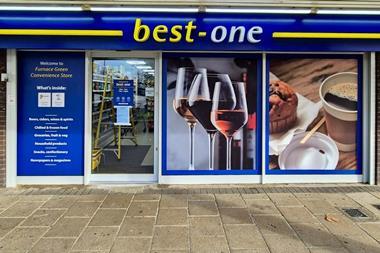Football fans can't get enough of Peter Crouch's '80s-style robot dance, while sci-fi buffs are queuing up to see the film version of '60s TV show Star Trek. Now it seems the food industry is reflecting the retro trend with a wave of product revivals, from Wispa bars to Wagon Wheels. So what exactly is driving this movement and how can retailers benefit from it? C-Store dons a neon shellsuit and Swatch watch to go in search of the answers.
"Given that much of the activity in retro is around impulse and convenience products, c-stores will definitely benefit, especially given there isn't the price competition from own label alternatives," says Kate Waddell, head of consumer brands at marketing consultancy Dragon Rouge.
Roger Dicker, who owns Kentford Village Stores, near Newmarket, Suffolk, is certainly making the most of the retro movement. "I started stocking Star bars recently and customers have really picked up on them," he says. "They like things that take them back to when they were kids."
The trend is being driven by a consumer need for security and nostalgia for better times, alongside a recognition that the next couple of years are going to be tough, explains Mintel retail analyst Richard Perks.
Sue Garfitt, head of insights, category and marketing planning at Burton's Foods, agrees: "In times of recession people seek familiarity, tending to experiment less and opting for comfort and things they know. Consumers gravitate towards brands they grew up with and know they can trust."
As well as the pleasure in being able to indulge in a comfort food, customers may also want to introduce others to their favourite childhood treat. "There is often the enjoyment that comes from knowing a parent or someone of an older generation is sharing something from their youth with their child or someone of a younger generation," Waddell says.
Kentford Village Stores has certainly had a good reaction to its retro products. "We sell all the products that were around when I was a child and we get plenty of people coming in saying: 'I remember that'," says Roger.
Senior consumer analyst Michelle Strutton believes that there is the potential for more brands from yesteryear to make a return. "Any brands that were re-named or dropped since the '70s or '80s could make a comeback to release that nostalgic feeling among today's 30- and 40-year olds, such as Spangles or Glees," she says.
Over time, retro may even venture beyond snacking to make an appearance at mealtimes, hints Waddell. "It could well be that, with the purse strings pulling, Fray Bentos and Spam could have their day, as consumers have the financial conditions as a rational reason to buy," she says. "Also, the return to old values makes consumption less stigmatised."
Perks is less convinced, believing that the retro trend isn't set to last. "The trend appears to be a reaction to impending recession, so the converse is probably true as well - as confidence and the economy begin to recover, so the attraction of retro products should wane. After all, I feel that Arctic Roll disappeared from our shelves for a reason."
In contrast, Waddell feels that there could be plenty of mileage left in products like Arctic Roll. "Often the more engineered launches, such as the Wispa campaign, are those that can show a peak in sales and then a rapid decline," she says. "The ones to watch are where the product offers a genuine point of difference. Assuming that Arctic Roll is still perceived as delicious, this could be a product that enjoys longer term success - there isn't anything similar, it is portionable, economic and appeals to kids and adults."
As well as stocking retro products retailers could use the trend as an excuse to introduce some in-store theatre. Says Waddell: "If there's a big TV success like Ashes to Ashes, or perhaps the remake of Minder, retailers might like to theme promotions in store."
It seems that the winning element of going retro is that it plays on consumers' emotions. Waddell shares her final words of wisdom: "It's all about plucking at the heart strings and creating the 'aaaah, remember that!' factor that makes them reach for their wallets."
So it's time to moonwalk your way back to the future and cash in on the retro revival.
"Given that much of the activity in retro is around impulse and convenience products, c-stores will definitely benefit, especially given there isn't the price competition from own label alternatives," says Kate Waddell, head of consumer brands at marketing consultancy Dragon Rouge.
Roger Dicker, who owns Kentford Village Stores, near Newmarket, Suffolk, is certainly making the most of the retro movement. "I started stocking Star bars recently and customers have really picked up on them," he says. "They like things that take them back to when they were kids."
The trend is being driven by a consumer need for security and nostalgia for better times, alongside a recognition that the next couple of years are going to be tough, explains Mintel retail analyst Richard Perks.
Sue Garfitt, head of insights, category and marketing planning at Burton's Foods, agrees: "In times of recession people seek familiarity, tending to experiment less and opting for comfort and things they know. Consumers gravitate towards brands they grew up with and know they can trust."
As well as the pleasure in being able to indulge in a comfort food, customers may also want to introduce others to their favourite childhood treat. "There is often the enjoyment that comes from knowing a parent or someone of an older generation is sharing something from their youth with their child or someone of a younger generation," Waddell says.
Kentford Village Stores has certainly had a good reaction to its retro products. "We sell all the products that were around when I was a child and we get plenty of people coming in saying: 'I remember that'," says Roger.
Senior consumer analyst Michelle Strutton believes that there is the potential for more brands from yesteryear to make a return. "Any brands that were re-named or dropped since the '70s or '80s could make a comeback to release that nostalgic feeling among today's 30- and 40-year olds, such as Spangles or Glees," she says.
Over time, retro may even venture beyond snacking to make an appearance at mealtimes, hints Waddell. "It could well be that, with the purse strings pulling, Fray Bentos and Spam could have their day, as consumers have the financial conditions as a rational reason to buy," she says. "Also, the return to old values makes consumption less stigmatised."
Perks is less convinced, believing that the retro trend isn't set to last. "The trend appears to be a reaction to impending recession, so the converse is probably true as well - as confidence and the economy begin to recover, so the attraction of retro products should wane. After all, I feel that Arctic Roll disappeared from our shelves for a reason."
In contrast, Waddell feels that there could be plenty of mileage left in products like Arctic Roll. "Often the more engineered launches, such as the Wispa campaign, are those that can show a peak in sales and then a rapid decline," she says. "The ones to watch are where the product offers a genuine point of difference. Assuming that Arctic Roll is still perceived as delicious, this could be a product that enjoys longer term success - there isn't anything similar, it is portionable, economic and appeals to kids and adults."
As well as stocking retro products retailers could use the trend as an excuse to introduce some in-store theatre. Says Waddell: "If there's a big TV success like Ashes to Ashes, or perhaps the remake of Minder, retailers might like to theme promotions in store."
It seems that the winning element of going retro is that it plays on consumers' emotions. Waddell shares her final words of wisdom: "It's all about plucking at the heart strings and creating the 'aaaah, remember that!' factor that makes them reach for their wallets."
So it's time to moonwalk your way back to the future and cash in on the retro revival.
Oldie but a goodie
For the retro trend to guarantee its endurance, it has to adapt. "Like most trends, it is likely to evolve if it is to survive," says Kate Waddell, head of consumer brands at Dragon Rouge. "Consumers tire of trends when they can be pastiched or become repetitive or predictable."
Burton's Foods has put this theory into practice. "Some of our older and more established brands are experiencing strong growth," says head of insights, category and marketing planning Sue Garfitt. "Wagon Wheels has seen a 10% increase in volume sales over the past year. Likewise, the ToffyPops brand has grown in volume by 15% and Viscount also remains as popular as ever - with all three benefiting from the retro trend (ACNielsen, 52 weeks to March 28, 2009)."
The key to longevity of the retro relaunch is making it relevant to the here and now, she says. "With Wagon Wheels, for example, we've invested in a marketing campaign with World Wrestling Entertainment.
By doing this we're making what is a popular favourite with dads just as relevant to a younger male audience, tapping into today's culture."
The firm has also gone on to develop new products based on popular brands. "We've also been expanding the formats of our most trusted brands so they can be consumed in more places and on more occasions," says Garfitt. "Jammie Dodgers Snack Bars and Maryland Munch Bars, for example, are products we've launched in the past 12 months that have taken firm favourites and expanded their footprint into new areas."
For the retro trend to guarantee its endurance, it has to adapt. "Like most trends, it is likely to evolve if it is to survive," says Kate Waddell, head of consumer brands at Dragon Rouge. "Consumers tire of trends when they can be pastiched or become repetitive or predictable."
Burton's Foods has put this theory into practice. "Some of our older and more established brands are experiencing strong growth," says head of insights, category and marketing planning Sue Garfitt. "Wagon Wheels has seen a 10% increase in volume sales over the past year. Likewise, the ToffyPops brand has grown in volume by 15% and Viscount also remains as popular as ever - with all three benefiting from the retro trend (ACNielsen, 52 weeks to March 28, 2009)."
The key to longevity of the retro relaunch is making it relevant to the here and now, she says. "With Wagon Wheels, for example, we've invested in a marketing campaign with World Wrestling Entertainment.
By doing this we're making what is a popular favourite with dads just as relevant to a younger male audience, tapping into today's culture."
The firm has also gone on to develop new products based on popular brands. "We've also been expanding the formats of our most trusted brands so they can be consumed in more places and on more occasions," says Garfitt. "Jammie Dodgers Snack Bars and Maryland Munch Bars, for example, are products we've launched in the past 12 months that have taken firm favourites and expanded their footprint into new areas."





























No comments yet